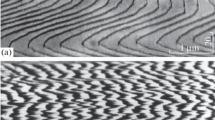Abstract
Reactions at semiconductor-vapour interfaces as stimulated thermally and by incident photon, electron and ion radiation permit a wide range of thin film transformations in the semiconductor surface to be carried out (1). The processes involved include: (i) dry etching of semiconductors, metals and dielectrics (ii) epitaxial growth of elemental and compound layers (iii) growth of dielectrics (iv) deposition of metals and metal alloys. Since photon, electron and ion beams can also be spatially defined, either through the use of physical masks or highly focussed beams, in theory it should therefore be possible to achieve in situ the complete fabrication of electronic devices and integrated circuits or their repair and modification. The chemistry underlying the processing methods involved is extremely complex. Even in the most chemically simple reaction, MBE of semiconducting materials from elemental beams under ultra-high vacuum, a number of surface processes must be taken into account in order to achieve a full description of the phenomena (2). When other processing techniques are examined, very many more factors must be looked at. Thus if complex compounds as opposed to the elements are employed, the chemical conversions demanded become more sophisticated and the fate of a variety of species generated in the reaction must be controlled. At higher pressures (MOVPE etc) the fluid dynamics in the reaction cell has an important influence. When photon, electron or ion beams are used elementary steps as excited electronically and by momentum transfer are brought into play; such steps can occur in the gaseous, adsorbed or substrate phases present. Nevertheless, the optimisation of particular processing methods must rest on achieving a good description of the underlying reactions. Since a significant (if not dominating) number of such reactions actually take place at the substrate-vapour interface, understanding the surface chemistry must be one of the major aims. In this article we therefore survey and illustrate some of the ways which might permit this to be achieved.
Access this chapter
Tax calculation will be finalised at checkout
Purchases are for personal use only
Preview
Unable to display preview. Download preview PDF.
Similar content being viewed by others
References
See, for example, papers contained within “Laser processing and dignastics (ll)” Bauere D: Kompa: KL and Laude: L(eds) E-MRS 11, (1986)
See, for example, Ploog: K Ann. Rev. Mat. Sci., 12 (1982) 123
Czanderna: AVJ(ed): Methods of Surface Analysis Elesevier, Amersterdam (1985)
Kowalczy: SP and Miller: DL J. APP. Phys. 59 (1986) 287
Ehrlich: DJ Tsao: JY and Bozler: CO J. Vac. Sci. Tech. B3 (1985) 1.
Jackman: RB Foord: JS Adams: AE and Lloyd: LJ. Appl. Phys. 59 (1986) 123
Chesters: MA J. Elec. Spec. 38 (1986) 123
Marra: WC Eisenberger: P and Cho: AY J. Appl. Phys. 50 (1979) 6927
Eisenberger: P and Marra: WC Phys. Rev. Letts 46 (1981) 1081
Robinson: IK Phys. Rev. Letts. 50 (1983) 1145
Bohr: J Feidenhars: R Nielsen: M Toney: M Johson: RJ and Robinson: IK Phys. Rev. Letts 54 (1985) 1275
TomsH: WK Mate: CM Zhu: XD Crowell: JE Heinz: TF Somorzair: GA and Shen: YR Phys. Rev. Letts. 52 (1984) 348
Chenr: CK Heinzr: TF Ricard: D and Shen: YR Phys. Rev. Letts 46 (1981) 1010
Tom: HVJK Zhu: XD Shen: YR and Somorjai: Ga Surf. Sci. 167 (1986) 167
Binning: G Rohrer: H Gerber: Ch and Weibels: E Appl. Phys. Letts 40 (1982) 178
Binnig: G Rohrer: H Gerber: Ch and Weibels: E Phys. Rev. Letts 50 (1983) 120
Jackman: RB Ebert: H and Foord: JS Surf. Sci. 176 (1986) 183
Author information
Authors and Affiliations
Editor information
Editors and Affiliations
Rights and permissions
Copyright information
© 1988 Martinus Nijhoff Publishers
About this chapter
Cite this chapter
Jackman, R.B., Foord, J.S. (1988). Surface Chemical Probes and their Application to the Study of in Situ Semiconductor Processing. In: Ehrlich, D.J., Nguyen, V.T. (eds) Emerging Technologies for In Situ Processing. NATO ASI Series, vol 139. Springer, Dordrecht. https://doi.org/10.1007/978-94-009-1409-4_30
Download citation
DOI: https://doi.org/10.1007/978-94-009-1409-4_30
Publisher Name: Springer, Dordrecht
Print ISBN: 978-94-010-7130-7
Online ISBN: 978-94-009-1409-4
eBook Packages: Springer Book Archive




